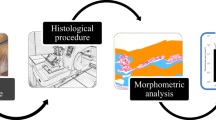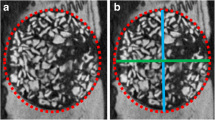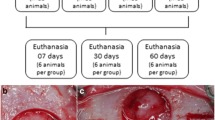Abstract
The aim of this experiment was to elucidate the histological alterations after systemic administration of eldecalcitol (ELD) combined with guided bone regeneration during the restoration of bone defect healing in rats. The femurs of 8-week-old Wister rats were used to generate bone defect models. The defect was covered with a collagen membrane, and ELD group was administrated with eldecalcitol (50 ng/kg body weight) intragastrically once every other day. Femora were harvested at 1, 2, 4 and 8 weeks post-surgery. Decalcify tissue slices were made and used for histological and immunohistochemical examination. Bone biomarkers of RANKL, OPG and osteocalcin (OCN) were detected by western blot. The results revealed that the system administration of ELD could improve new bone formation demonstrated by the increased bone volume/tissue volume ratio and accelerated mineralization. ELD suppressed osteoclastic bone resorption by reducing the number of osteoclasts, decreasing the expression of cathepsin-K and the ratio of RANKL/OPG at the early stage of bone defect restoration (1 and 2 weeks) and upregulating OCN expression at the later stage of bone defect healing (4 and 8 weeks). These data suggested that systemic administration of eldecalcitol accelerated bone formation and promoted bone maturation by decreasing bone resorption and promoting bone mineralization during bone defect restoration.








Similar content being viewed by others
References
Boskey AL, Gadaleta S, Gundberg C, Doty SB, Ducy P, Karsenty G (1998) Fourier transform infrared microspectroscopic analysis of bones of osteocalcin-deficient mice provides insight into the function of osteocalcin. Bone 23:187–196
Cao YP et al (2007) 1 alpha,25-dihydroxy-2 beta(3-hydroxypropoxy)vitamin D-3 (ED-71) suppressed callus remodeling but did not interfere with fracture healing in rat femora. Bone 40:132–139. doi:10.1016/j.bone.2006.07.023
Chenu C et al (1994) Osteocalcin induces chemotaxis, secretion of matrix proteins, and calcium-mediated intracellular signaling in human osteoclast-like cells. J Cell Biol 127:1149–1158
de Freitas PH et al (2011) Eldecalcitol, a second-generation vitamin D analog, drives bone minimodeling and reduces osteoclastic number in trabecular bone of ovariectomized rats. Bone 49:335–342. doi:10.1016/j.bone.2011.05.022
DeLuca HF (1988) The vitamin D story: a collaborative effort of basic science and clinical medicine FASEB journal: official publication of the Federation of American Societies for. Exp Biol 2:224–236
Ducy P et al (1996) Increased bone formation in osteocalcin-deficient mice. Nature 382:448–452. doi:10.1038/382448a0
Feng W et al (2015) Histochemical examination of adipose derived stem cells combined with beta-TCP for bone defects restoration under systemic administration of 1alpha,25(OH)2D3. Mater Sci Eng C, Mater Biol Appl 54:133–141. doi:10.1016/j.msec.2015.05.037
Futran ND (2006) Peterson’s principles of oral and maxillofacial surgery, 2nd edition by Michael Miloro, B.C. Decker, Inc., Hamilton, 2004, 1500 pp Head & Neck 28:378–379 doi:10.1002/hed.20401
Harada S et al (2012) Daily administration of eldecalcitol (ED-71), an active vitamin D analog, increases bone mineral density by suppressing RANKL expression in mouse trabecular bone Journal of bone and mineral research. Off J Am Soc Bone Miner Res 27:461–473. doi:10.1002/jbmr.555
Hauschka PV, Wians FH Jr (1989) Osteocalcin-hydroxyapatite interaction in the extracellular organic matrix of bone. Anat Rec 224:180–188. doi:10.1002/ar.1092240208
Li M et al (2013) Histological examination on osteoblastic activities in the alveolar bone of transgenic mice with induced ablation of osteocytes. Histol Histopathol 28:327–335
Liu H et al (2015) Local administration of calcitriol positively influences bone remodeling and maturation during restoration of mandibular bone defects in rats. Mater Sci Eng C Mater Biol Appl 49:14–24. doi:10.1016/j.msec.2014.12.064
Liu J, Kerns DG (2014) Mechanisms of guided bone regeneration: a review. Open Dent J 8:56–65. doi:10.2174/1874210601408010056
Liu W et al (2014) Vitamin D supplementation enhances the fixation of titanium implants in chronic kidney disease mice. PLoS ONE 9:e95689. doi:10.1371/journal.pone.0095689
Matsumoto T, Kubodera N (2007) ED-71, a new active vitamin D3, increases bone mineral density regardless of serum 25(OH)D levels in osteoporotic subjects. J Steroid Biochem 103:584–586. doi:10.1016/j.jsbmb.2006.12.088
Matsumoto T et al (2005) A new active vitamin D, ED-71, increases bone mass in osteoporotic patients under vitamin D supplementation: a randomized, double-blind, placebo-controlled clinical trial. J Clin Endocrinol Metab 90:5031–5036. doi:10.1210/jc.2004-2552
Matsumoto T, Takano T, Yamakido S, Takahashi F, Tsuji N (2010) Comparison of the effects of eldecalcitol and alfacalcidol on bone and calcium metabolism. J Steroid Biochem Mol Biol 121:261–264. doi:10.1016/j.jsbmb.2010.03.035
Meyer MB, Benkusky NA, Lee CH, Pike JW (2014) Genomic determinants of gene regulation by 1,25-dihydroxyvitamin D3 during osteoblast-lineage cell differentiation. J Biol Chem 289:19539–19554. doi:10.1074/jbc.M114.578104
Nikel O, Laurencin D, McCallum SA, Gundberg CM, Vashishth D (2013) NMR investigation of the role of osteocalcin and osteopontin at the organic-inorganic interface in bone. Langmuir ACS J Surf Colloids 29:13873–13882. doi:10.1021/la403203w
Oda K et al (1999) A general method for rapid purification of soluble versions of glycosylphosphatidylinositol-anchored proteins expressed in insect cells: an application for human tissue-nonspecific alkaline phosphatase. J Biochem 126:694–699
Okano T, Tsugawa N, Masuda S, Takeuchi A, Kobayashi T, Takita Y, Nishii Y (1989) Regulatory activities of 2 beta-(3-hydroxypropoxy)-1 alpha, 25-dihydroxyvitamin D3, a novel synthetic vitamin D3 derivative, on calcium metabolism. Biochem Biophys Res Commun 163:1444–1449. doi:10.1016/0006-291X(89)91140-6
Poundarik AA, Diab T, Sroga GE, Ural A, Boskey AL, Gundberg CM, Vashishth D (2012) Dilatational band formation in bone. Proc Natl Acad Sci USA 109:19178–19183. doi:10.1073/pnas.1201513109
Ritter NM, Farach-Carson MC, Butler WT (1992) Evidence for the formation of a complex between osteopontin and osteocalcin Journal of bone and mineral research. Off J Am Soc Bone Miner Res 7:877–885. doi:10.1002/jbmr.5650070804
Saito H, Takeda S, Amizuka N (2013) Eldecalcitol and calcitriol stimulates ‘bone minimodeling’, focal bone formation without prior bone resorption, in rat trabecular bone. J Steroid Biochem Mol Biol 136:178–182. doi:10.1016/j.jsbmb.2012.10.004
Shiraishi A et al (1999) The advantage of alfacalcidol over vitamin D in the treatment of osteoporosis. Calcif Tissue Int 65:311–316
Suda T, Takahashi F, Takahashi N (2012) Bone effects of vitamin D—Discrepancies between in vivo and in vitro studies. Arch Biochem Biophys 523:22–29. doi:10.1016/j.abb.2011.11.011
Sun J et al (2016) Histochemical examination of the effects of high-dose 1,25(OH)2D3 on bone remodeling in young growing rats. J Mol Histol 47:389–399. doi:10.1007/s10735-016-9681-4
Tsurukami H, Nakamura T, Suzuki K, Sato K, Higuchi Y, Nishii Y (1994) A novel synthetic vitamin D analogue, 2β-(3-hydroxypropoxy)1α, 25-dihydroxyvitamin D3 (ED-71), increases bone mass by stimulating the bone formation in normal and ovariectomized rats. Calcif Tissue Int 54:142–149. doi:10.1007/bf00296065
Tzioupis CC, Giannoudis PV (2006) The safety and efficacy of parathyroid hormone (PTH) as a biological response modifier for the enhancement of bone regeneration. Curr Drug Safe 1:189–203
Uchiyama Y et al (2002) ED-71, a vitamin D analog, is a more potent inhibitor of bone resorption than alfacalcidol in an estrogen-deficient rat model of osteoporosis. Bone 30:582–588. doi:10.1016/s8756-3282(02)00682-8
van Driel M, van Leeuwen JP (2014) Vitamin D endocrine system and osteoblasts. Bone Key Rep 3:493. doi:10.1038/bonekey.2013.227
Zhou C, Li Y, Wang X, Shui X, Hu J (2012) 1,25Dihydroxy vitamin D(3) improves titanium implant osseointegration in osteoporotic rats Oral surgery, oral medicine, oral pathology and oral radiology 114:S174-178 doi:10.1016/j.oooo.2011.09.030
Acknowledgements
This study was partially supported by the National Nature Science Foundation of China (Grant Nos. 81271965; 81470719; 81611140133) to Li M. Authors thank Dr. Hitoshi Saito at Chugai Pharmaceutical for providing the information of eldecalcitol.
Author information
Authors and Affiliations
Corresponding author
Additional information
Xiuchun Han and Juan Du have equally contributed to this article.
Rights and permissions
About this article
Cite this article
Han, X., Du, J., Liu, D. et al. Histochemical examination of systemic administration of eldecalcitol combined with guided bone regeneration for bone defect restoration in rats. J Mol Hist 48, 41–51 (2017). https://doi.org/10.1007/s10735-016-9705-0
Received:
Accepted:
Published:
Issue Date:
DOI: https://doi.org/10.1007/s10735-016-9705-0




